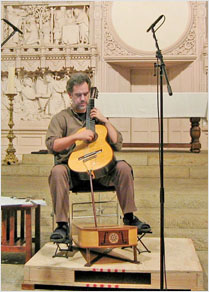
Johann Sebastian Bach, Sonatas and Partitas for Solo Violin, BWV 1001-1006, arranged for 8-string guitar and played by Paul Galbraith on Bach: the Sonatas and Partitas.
I saw Paul Galbraith perform this in its entirety at Riverside and was immediately struck by his unusual instrument, his incredibly ambitious transcriptions of keyboard works for the guitar, and his meditative, deep playing. I bought this CD of his on the way out and have loved it ever since.
The easiest thing to describe is his instrument. It's an eight-string guitar! The standard classical guitar has six strings tuned to E, A, D, G, B, and E, with the high E two octaves above the low one. Galbraith has an extra string tuned to an A a fourth above the usual high E, which lets him avoid playing highest notes way up the neck where the sound is less clear. He also has an extra low string, tuned to an A a fifth below the usual low E, which him play bass notes that a normal guitar just can't get. As if this weren't enough, his guitar is supported by a metal endpin like that of a cello, and it stands on a wooden resonance box. He holds the guitar almost like a cello player does.

As for Bach's sonatas and partitas, words fail me when it comes to describing their grandeur. The brilliant, soaring spirit of these pieces comes through more clearly when, say, Itzhak Perlman plays them on the violin, but with the warmth of the guitar, Galbraith makes them more human and meditative.
Here's what Galbraith has to say about Bach's sonatas and partitas:
As long ago as 1958, Julian Bream published an article in Guitar Review to the effect that the Six Violin Sonatas and Partitas were ideal for the guitar, as if they'd been written for the instrument. Bach's own fluid concept of possible interchange between instruments in these works can be clearly seen from the fact that the Third Violin Partita exists in an original lute version (BWV 1006A), and that the Second Violin Sonata also exists in a keyboard version.He goes on to say his personal impression is that the whole extended piece is an "instrumental gospel story in triptych form".For my own transcription of the Sonatas and Partitas, or "6 Solo", to use Bach's own title - I have drawn from Bach's own transcriptions as well as the contemporaneous lute adaptations of the Fugue from Sonata I and Brahms' marvellous piano version of the Chaconne for left hand alone. For the remaining works, I've treated the arrangements according to the demands of the music, since the texture of the writing varies considerably throughout. To my mind the variation in texture was intentional on Bach's part, in order to provide diversity and contrast. So there are times when I felt it was vital to refrain from adding anything to entire single-line movements. The Doubles in Partita I, for example, suggest a rich polyphonic texture largely through a conscious suppression of "filling-out". But there are also occasions when the music seems to demand a fuller realization, and here I've made full use of the Baroque lute range of my 8-string guitar.
Bach wrote the set in alternating forms: Sonata I, Partita I, Sonata II, Partita II, Sonata III, Partita III. Some other readings have grouped the three Sonatas together and the three Partitas separately. Not that these versions don't work well! But it had been a dream of mine for some time to perform the "6 Solo" in the way in which it was composed, since I had a strong intuition that it was composed as a single piece, like a "suite of suites".
It was with the the development of my new 8-string guitar in 1994 that I found a way to perform the music "in one go", since the instrument's extra high and low strings permitted the same tuning to be used throughout. While studying it on this instrument, and performing it over several years, I began to perceive the interconnections within the music.
baez@math.removethis.ucr.andthis.edu
© 2005 John Baez